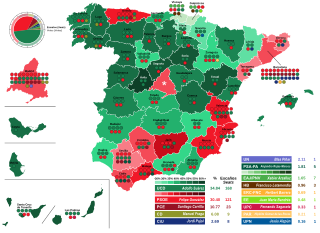Top Qs
Timeline
Chat
Perspective
1979 Spanish general election
From Wikipedia, the free encyclopedia
Remove ads
A general election was held in Spain on Thursday, 1 March 1979, to elect the members of the 1st Cortes Generales under the Spanish Constitution of 1978. All 350 seats in the Congress of Deputies were up for election, as well as all 208 seats in the Senate. This was the first election held under the new constitution that had been approved in a referendum on 6 December 1978 and which had lowered the voting age from 21 to 18, resulting in an increase of the electoral roll by three million people.
The Union of the Democratic Centre (UCD) remained the largest party, winning 168 of the 350 seats in the Congress of Deputies and 119 of the 208 seats in the Senate. The Spanish Socialist Workers' Party (PSOE), which had merged with the People's Socialist Party (PSP) and was widely expected to make large gains—with some opinion polls predicting a narrow win—fell short of expectations and lost ground when compared to the combined totals for the PSOE–PSP alliance in the 1977 election. The Communist Party of Spain (PCE) obtained the best result in its history, whereas Manuel Fraga's Democratic Coalition (CD)—an electoral bloc formed by the People's Alliance (AP), the Liberal Citizens Action (ACL) and the Progressive Democratic Party (PDP)—lost nearly half of its seats. The election would also see the best showing of the far-right in Spain until the April 2019 election, as Blas Piñar-led National Union (UN) would secure one seat with 2.1% of the vote share.
As a result of the election, Prime Minister Adolfo Suárez went on to form a minority government, depending on support from the CD and other minor parties such as the Socialist Party of Andalusia–Andalusian Party (PSA–PA), the Regionalist Aragonese Party (PAR) and the Navarrese People's Union (UPN).
Remove ads
Overview
Summarize
Perspective
Under the 1978 Constitution, the Spanish Cortes Generales were envisaged as an imperfect bicameral system.[1][2] The Congress of Deputies had greater legislative power than the Senate, having the ability to vote confidence in or withdraw it from a prime minister and to override Senate vetoes by an absolute majority of votes.[3] Nonetheless, the Senate possessed a limited number of functions—such as ratification of international treaties, authorization of collaboration agreements between autonomous communities, enforcement of direct rule, regulation of interterritorial compensation funds, and its role in constitutional amendment and in the appointment of members to the Constitutional Court and the General Council of the Judiciary—which were not subject to the Congress's override.[4]
Electoral system
Voting for each chamber of the Cortes Generales was on the basis of universal suffrage, which comprised all nationals over 18 years of age and in full enjoyment of their political rights.[5][6][7]
The Congress of Deputies was entitled to a minimum of 300 and a maximum of 400 seats, with the electoral law setting its size at 350. 348 members were elected in 50 multi-member constituencies—corresponding to the provinces of Spain, with each being allocated an initial minimum of two seats and the remaining 248 being distributed in proportion to their populations, at a rate of approximately one seat per each 144,500 inhabitants or fraction greater than 70,000—using the D'Hondt method and a closed list proportional voting system, with an electoral threshold of three percent of valid votes (which included blank ballots) being applied in each constituency. Seats were allocated to constituencies, corresponding to the provinces of Spain. The two remaining seats were allocated to Ceuta and Melilla as single-member districts and elected using plurality voting.[5][8] The use of the electoral method resulted in a higher effective threshold based on the district magnitude and the distribution of votes among candidacies.[9]
As a result of the aforementioned allocation, each Congress multi-member constituency was entitled to the following seats:[10][11]
208 seats in the Senate were elected using an open list partial block voting system: in constituencies electing four seats, electors could vote for up to three candidates; in those with two or three seats, for up to two candidates; and for one candidate in single-member districts. Each of the 47 peninsular provinces was allocated four seats, whereas for insular provinces, such as the Balearic and Canary Islands, districts were the islands themselves, with the larger (Mallorca, Gran Canaria and Tenerife) being allocated three seats each, and the smaller (Menorca, Ibiza–Formentera, Fuerteventura, La Gomera, El Hierro, Lanzarote and La Palma) one each. Ceuta and Melilla elected two seats each. Additionally, autonomous communities could appoint at least one senator each and were entitled to one additional senator per each million inhabitants.[12][13][14]
The law provided for by-elections to fill seats vacated in the Congress only when the results in a particular constituency were annulled by a final court's decision deriving from the election's legal challenge procedures; instead, any vacancies that occurred after the proclamation of candidates and into the legislative term were to be covered by the successive candidates in the list and, when required, by the designated substitutes. Additionally for the Senate, by-elections were mandated to fill any seat vacated up to two years into the legislative term.[15]
Eligibility
Spanish citizens of age and with the legal capacity to vote could run for election. Causes of ineligibility were imposed on the following officials:[16][17]
- The holders of a number of positions: the president and members of the Constitutional Court, the Supreme Court, the Council of State, the Court of Auditors and the Council of National Economy; the Ombudsman; high-ranking members—undersecretaries, directors-general and similar positions, as well a those who performed functions conferred by decree approved by the Council of Ministers—of the State Administration, the Social Security and other government agencies; government delegates in the autonomous communities, and civil governors and sub-governors; members of electoral commissions; and the chairs of national trade unions, as well as those holding non-elective union positions at the national level;
- Judges and public prosecutors in active service;
- Personnel of the Armed Forces (Army, Navy and Air Force) and law enforcement corps in active service.
Other causes of ineligibility for both chambers were imposed on a number of territorial-level officers in the aforementioned categories—during their tenure of office—in constituencies within the whole or part of their respective area of jurisdiction.[16][17] Incompatibility provisions extended to the impossibility of simultaneously holding the positions of deputy and senator.[17][18]
The electoral law allowed for parties and federations registered in the interior ministry, alliances and groupings of electors to present lists of candidates. Parties and federations intending to form an alliance ahead of an election were required to inform the relevant electoral commission within fifteen days of the election call, whereas groupings of electors needed to secure the signature of at least one permille—and, in any case, 500 signatures—of the electorate in the constituencies for which they sought election, disallowing electors from signing for more than one list of candidates.[19]
Election date
The term of the Cortes elected in the 1977 election was not to be continued beyond 15 June 1981, in the event they were not dissolved earlier.[20] An election was required to be held within from 30 to 60 days after the date of expiry of the Cortes,[5] setting the latest possible date for election day on Friday, 14 August 1981.
The prime minister had the prerogative to propose the monarch to dissolve both chambers at any given time—either jointly or separately—and call a snap election, provided that no motion of no confidence was in process, no state of emergency was in force and that dissolution did not occur before one year had elapsed since the previous one.[21] Additionally, both chambers were to be dissolved, and a new election called, if an investiture process failed to elect a prime minister within a two-month period from the first ballot.[22] Barring this exception, there was no constitutional requirement for simultaneous elections to the Congress and the Senate.[23] Still, as of 2025, there has been no precedent of separate elections taking place under the 1978 Constitution.
The Cortes were officially dissolved on 1 January 1979 with the publication of the dissolution decree in the Official State Gazette (BOE), setting election day for 1 March and scheduling for both chambers to reconvene on 23 March (for the Congress) and 27 March (for the Senate).[11]
Remove ads
Parties and candidates
Summarize
Perspective
Below is a list of the main parties and electoral alliances which contested the election:
Remove ads
Opinion polls
Results
Congress of Deputies
Senate
Maps
- Election results by constituency (Congress).
- Vote winner strength by constituency (Congress).
- Vote winner strength by autonomous community (Congress).[d]
Remove ads
Aftermath
Government formation
1980 motion of no confidence
1980 motion of confidence
1981 investiture
Remove ads
Notes
- This territorial division is based on the autonomic system established under the Spanish Constitution of 1978, as opposed to the regional division established in 1833. Most autonomous communities would be constituted by the time of the 1982 election, with the rest being established in early 1983. The autonomous cities of Ceuta and Melilla would not be constituted as independent administrative entities until 1995.
- PSC–PSOE (7 senators) and ERC (1 senator), which contested the 1977 Senate election within the Entesa alliance, joined the Nova Entesa alliance ahead of the 1979 Senate election.
- PSUC (4 senators), which contested the 1977 Senate election within the Entesa alliance, joined the Per l'Entesa alliance ahead of the 1979 Senate election.
- The percentage of blank ballots is calculated over the official number of valid votes cast, irrespective of the total number of votes shown as a result of adding up the individual results for each party.
Remove ads
References
Bibliography
External links
Wikiwand - on
Seamless Wikipedia browsing. On steroids.
Remove ads























